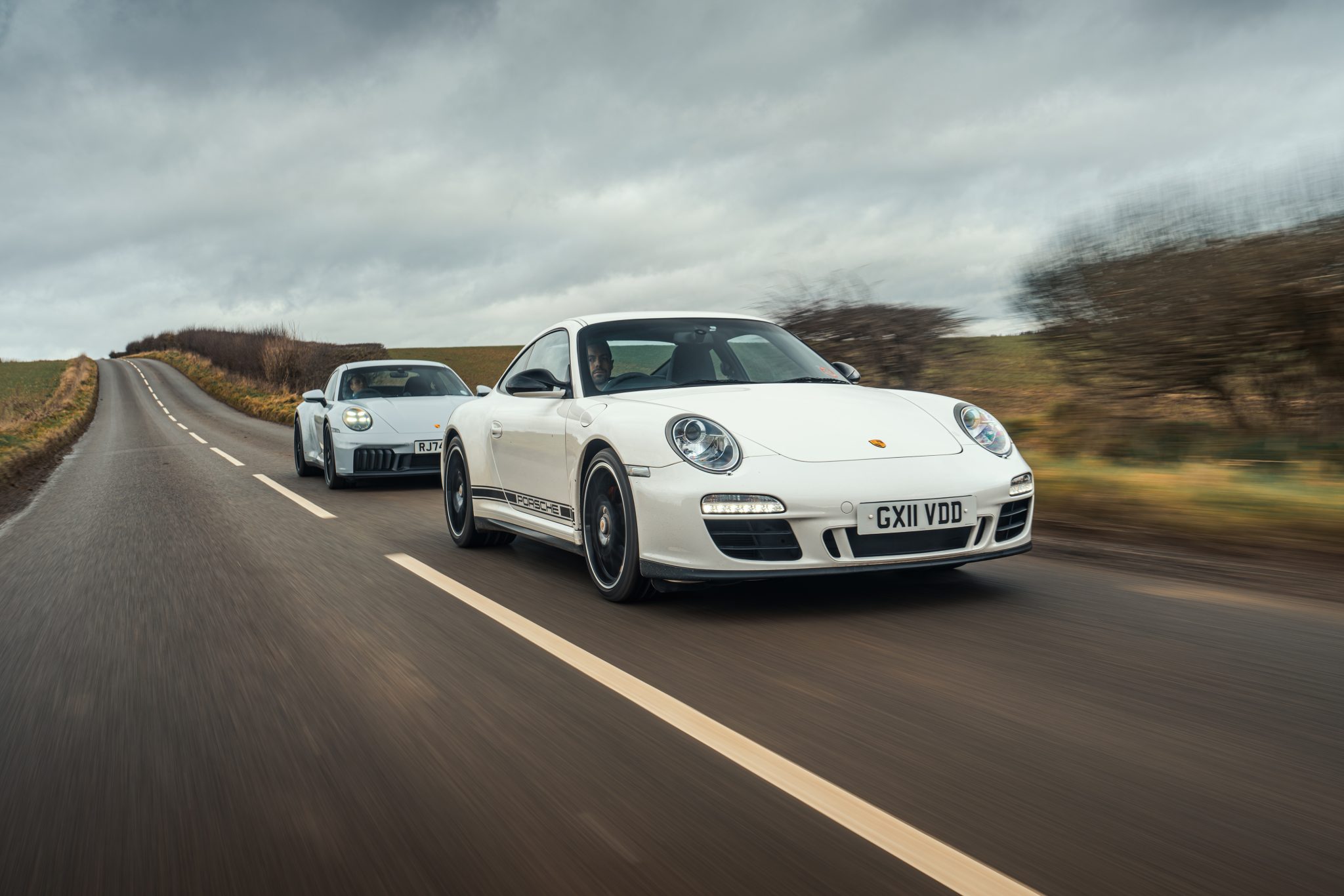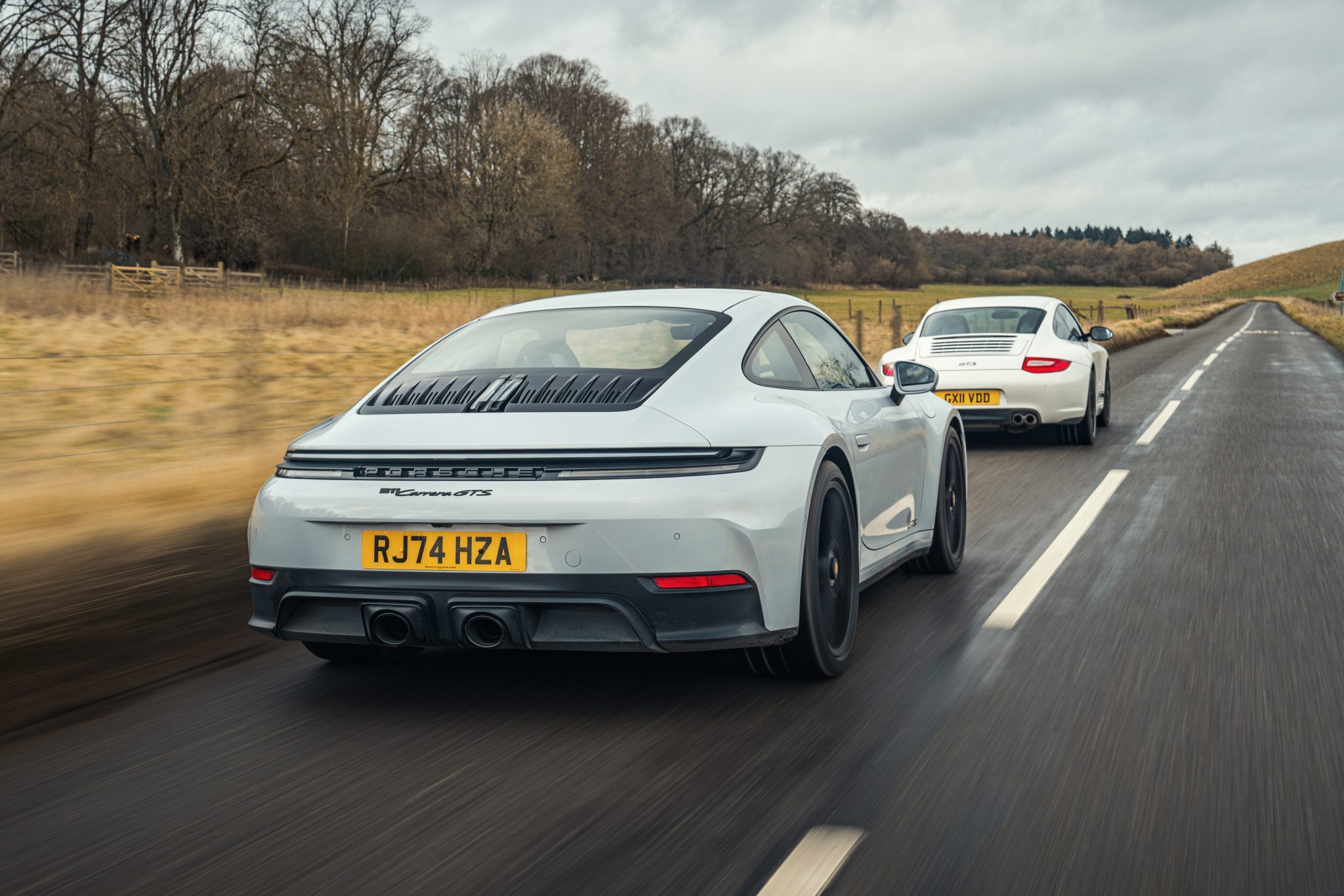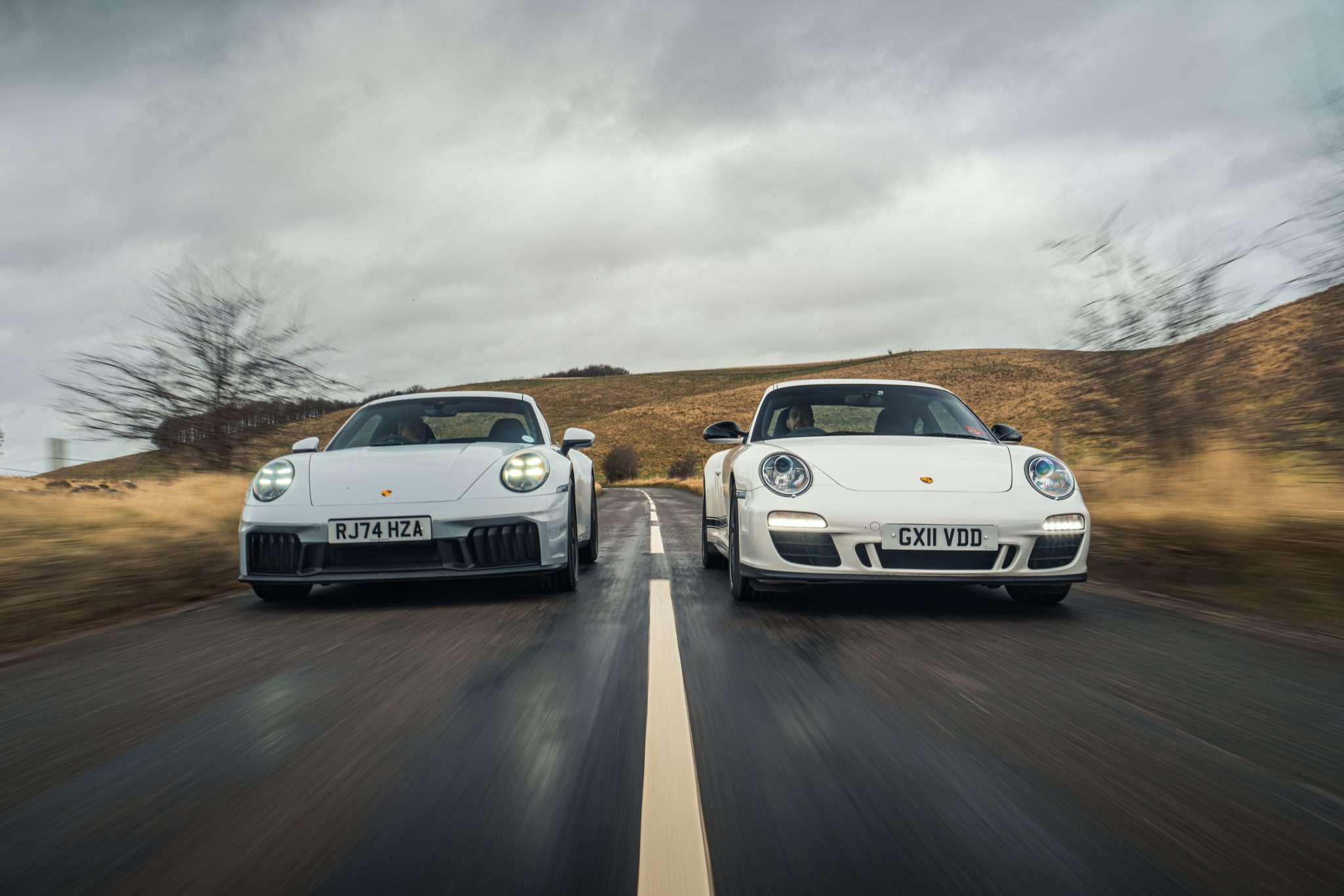Porsche 992 GTS T-Hybrid vs 997 GTS: A Modern Classic Meets an Icon
What Made the 997 GTS Special
The champagne corks must have flown high over Stuttgart the day they thought of the original Porsche 911 Carrera GTS. What it needed was a means of bringing the 996/997 series of cars – the first of the water-cooled 911s – into a gentle landing before an all-new breed of 911, complete with a longer wheelbase and electric steering, took over.
Of course there’d been all manner of low volume specials like the GT2 RS, GT3 RS 4.0, Speedster and Sport Classic to keep the name in the headlines, but what Porsche really wanted was a low cost (to Porsche) way of also keeping the cars flowing out of the showrooms. So it dredged up a nameplate first used by the 904 GTS racer in the 1960s and not since the 928 GTS of the 1990s, flipped over the lid of the parts bin and went for a rummage.
A Modest Upgrade, A Big Impact
Inside it found a box marked ‘GT3’ and decided to leave that well alone – no need for fancypants motorsports bits here. Instead the GTS became the first non-motorsport production 911 to combine the wide body with rear-wheel drive – though to be fair both had been available on the Sport Classic and Speedster. The engine came from the Sport Classic but could just as easily have been found on a standard Carrera S with the ‘Powerkit’ option selected. A sports exhaust and PASM adaptive dampers were made standard rather than optional, but the really juicy goodies – sport suspension, ceramic brakes and a limited-slip differential, remained on the extras list.
What you did get was a new front splitter, centre lock alloy wheels, a Sport Design steering wheel, lashings of Alcantara, no cost option rear seats and a smattering of GTS badges. And, as if in tacit acknowledgement of just how modest were Porsche’s aspirations for this car, the cost of upgrading from Carrera S to GTS was just £2152.
Enter the 992 Carrera GTS T-Hybrid
Now look at the new 992 Carrera GTS T-Hybrid compared to a modern Carrera S. While the S has the old 3-litre engine now developing 473bhp, the GTS has a brand new 3.6-litre motor with hybrid attached yielding 533bhp. There’s 450lb ft of torque instead of 390lb ft. It’s 0.3sec quicker to 62mph which, in the traction limited world of rear-wheel drive, is significant to say the least. Perhaps most significantly of all, the price walk from one to the other is now £12,800, though that includes now standard rear-wheel steering. And if you want to understand how important this once last minute afterthought sub-brand now is to Porsche, it was not the last of the second-generation 992s to be launched, but the very first. The GTS has succeeded beyond, I expect, even Porsche’s fondest expectations.
But how changed is it, really? Not just on paper, but out there where it really matters, on the kind of roads on which such cars were born to be driven. We thought it no more than our professional duty to find out…

Photography by Mark Riccioni
A Mid-Spec Model with Serious Power
Everyone who drives the new GTS for the first time gets out and says the same thing, which is one variation or another on the ‘I just cannot believe how damned fast it is’ theme. I was no different. When I attended the car’s launch last year I could barely believe how quickly it blasted me out of the blocks, until some kind boffin explained that, thanks to instant response of the new hybrid system the car is actually quicker over the first few yards than a 911 Turbo S. It feels that way too. The second thing new recruits say, very much apropos of the first is, ‘what the hell’s the new Turbo going to be like?’ But while that delight awaits us, I can confirm that not once in the four days I was with the GTS did I crave a single additional horsepower. Perhaps because it boasts more power today than the second-generation 997 Turbo S, the ultimate 911 Turbo of that era.
This, then, may still be the ‘mid-spec’ 911 but it is likely to be the most powerful you’ll be able to buy with rear-wheel drive (unless and until Porsche produces a new GT2 RS). Indeed, now as then, you can buy your GTS with rear or four-wheel drive, and a coupé or convertible roof. All you can no longer have is a manual gearbox because it cannot be integrated into the workings of the hybrid drive. I understand why, but it remains a crying shame all the same.
Versatility Meets Raw Speed
The 992 GTS is a car of distinctly different characters, which is entirely to its credit even if this particular car’s spec – full bucket non-reclining front seats, no rear seats, thin glass and Goodyear tyres – is not best for accentuating the more laid back aspects of its personality. But it will still waft around quite anonymously and, with its new digital dash, what seems like most of the App Store on the central display and easily configured shortcuts to disable the more hateful ‘assistance’ systems, it’s as easy to live with as any modern car could reasonably hope to be.
But then you want to get on with it a bit – not go nuts, but make some progress and it’s all just so easy. There’s torque everywhere, and if you just turn the steering wheel control to ‘Sport’ it sharpens the throttle to a fine edge. It’s best also to go for manual gear selection as left to its own devices, it’s too eager to jump down a stack of gears when you want just to squirt past something, as if no one has told the gearbox just how much get up and go this engine has.
Which you’ll only really find out for yourself if you drive through this phase and into the wild west beyond. It seems so strange to write this about a ‘mere’ GTS, but there were times I could barely believe how fast it would go or how brutal it felt.
Table of contents

Photography by Mark Riccioni
Behind the Wheel of the 997 GTS
What possible reply could a 15-year-old parts bin special like the 997 GTS have for that? Peter Dixon’s car provides the perfect way of finding out. Unlike so many that are advertised, it’s a rear-drive, manual coupé, unquestionably the most desirable configuration for a 997 GTS. It’s in perfect condition, has just 45,000 miles on the clock and precisely zero options that might alter the way it gets down a road. This is the 997 GTS at its simplest and best.
It’s a very pretty car but it looks quite old now, especially from the rear, a fact that’s only surprising until you remember this essential shape went on sale with the launch of the 996 some 27 years ago. The cabin is simple and the Alcantara-trimmed wheel entirely unadorned. It’s worth mentioning briefly for anyone toying with the idea of a PDK car that unless the paddle option was specified, it came with those dreadful rocker switches on the wheel which should be avoided at all costs. There’s that classic five dial binnacle of gauges ahead and some easily accessed old school ventilation controls beneath the predictably state of the ark navigation system. It starts by inserting a key into the ignition and twisting it. Fancy that.
One move of hand and foot reminds at once what 911s have lost in recent years. That six-speed gearbox with its oily, mechanical action is a simple delight, denied to all but GT3 customers from this car’s replacement forward. Even the much modified seven-speed, which was available in the GTS until now, is no patch on it.
The engine is quieter than that of modern GTS, with a less angry timbre, and my goodness it’s smooth. There’s more torque low down than I expected, but at 3.8 litres this is as big as a non-GT 911 engine has ever grown and, being from the second generation of 997 models, free from the well documented reliability issues that have so damaged the reputations of earlier non-Turbo and GT 996s and 997s. But its performance is not even close to that of the new car.
Indeed most of the time the original 911 GTS is no quicker than a Carrera S of the same era because its power curve plots an identical trace from idle to the far side of 6000rpm. It has no more torque, either. It’s only at the top end, when the S engine is starting to flag that special flaps open in the intake, allowing the GTS to fill its lungs and power on to 7300rpm.
Table of contents

Photography by Mark Riccioni
Performance Comparison: Old vs New
Looking back at the stories I wrote about this car 15 years ago, one phrase struck me, written after my initial impressions were safely in the bag. ‘So far, so fairly good’. Yes, the standard by which it was being judged were those of the finest sports car of its era but, even so, for a new car bearing a new nameplate, I had clearly hoped for more.
But here’s the thing with the old GTS. Look hard enough and more you will find. I found it because the car needed some fuel and it turned out the nearest station was a dozen miles away on roads I didn’t know. Brilliant roads as it turned out. And now the GTS started to do its thing. Nicely warm and with legs properly stretched, it too acquired another personality. Not that of the all-powerful, all-conquering warrior king like the new GTS, but the ablest, most agile officer on the field. And this is where its one great strength over even the newest and cleverest 911 is most apparent.
It’s that 175kg weight difference. Now, it’s actually quite impressive the figure is not even higher given that the 992 is a physically larger car, packed with safety and luxury equipment the 997 lacks, bigger brakes, wheels, tyres, beefier suspension and four-wheel steering, not to mention the small matter of an electric motor, battery pack and all the stuff required to integrate a hybrid system into the powertrain, but there it still is.
And the result for the 997, combined with a 100mm shorter wheelbase and hydraulic rather than electro-mechanical power steering is a car that feels not just lighter, but more lithe too. I missed my vocation as a World War Two fighter pilot, but in my mind’s eye I’d like to imagine it’s like the difference between a Spitfire and a Mosquito – the latter more modern, heavy and powerful than the former, both perfectly adapted to their respective mission profiles.
What I do know is that back in 2010 having at last hurled the GTS over a mountain pass, enjoyed myself so much I turned around and ascended the summit once more, I parked up and tweeted the first words to come into my brain. Which were: ‘Carrera GTS three pedal coupe. Std susp. Possibly the best only car in the world.’ Back in the present, after that run to and from the fuel station in Peter’s car, a journey during which I let it show me all it could do, I needed little reminding why I wrote those words. Like so many of the world’s best cars, it had nothing to do with how fast I was going or how much grip the tyres were generating, and everything to do with how it felt and, as a result, how it made me feel while it was doing it. And for some time after too.
On the same roads the new GTS felt hemmed in, reduced to those small squirts of acceleration that would eliminate any straight in an instant. I could use but a fraction of its available performance, whereas in the old car there were places I could use almost all of it. Which, to be scrupulously fair, says as much and probably more about the roads we were on than the cars we were driving.
Table of contents

Photography by Mark Riccioni
Driving the Porsche 911 S/T: A Test of Precision
But on Michelin Cup 2 tyres, you simply daren’t press on too hard in such conditions. Because it wasn’t also cold, the rubber could actually generate quite high levels of both longitudinal and lateral adhesion, but when they started to go, their breakaway characteristics were somewhat sudden. No delicious progressive slides, there to be joyously ridden out on the throttle, just slip, skid, save. Why, on a car it describes explicitly as so optimised for road use they’ve not even set a lap time in it, has Porsche decided to fit track day tyres? It makes no sense in such a car to push the limit so far away that it’s all but inaccessible on public roads that are dry, while lending the car a somewhat spiky persona on those that are not. Were I to be blessed with such a car, job one would be to find some rubber that sacrificed some of the grip I’d neither want nor need, for the right not to be scared every time it rained.
Table of contents
|
|
Carrera GTS T-Hybrid (992) |
Carrera GTS (997) |
| Engine | 3561cc, 6-cyl, turbo, hybrid | 3800cc, 6-cyl, naturally aspirated |
| Transmission | 8-speed dual-clutch, RWD | 6-speed manual, RWD (PDK optional) |
| Power | 533bhp | 402bhp @ 7300rpm |
| Torque | 450lb ft | 310lb ft @ 4200rpm |
| Weight | 1595kg | 1420kg |
| Power to Weight | 334bhp/tonne | 283bhp/tonne |
| 0-62mph | 3.0sec | 4.6sec |
| Top Speed | 194mph | 190mph |
| Price new: | £132,600 | £78,371 (2011) |
| Price now: | £70,000 (manual), £55,000 (PDK) |



